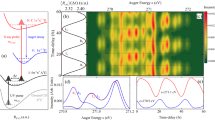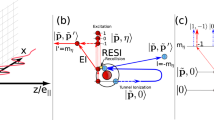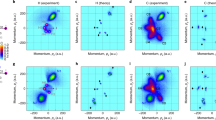Abstract
The emission of coherent XUV radiation from atomic or molecular gases exposed to intense infrared laser pulses, known as high harmonic generation, is of paramount interest in atomic and molecular physics as well as in attosecond science. The emitted radiation contains a wealth of information about the structure of its generating medium, which inspired vigorous efforts to tomographically image the valence orbital of atoms and molecules. The orbital retrieval is nevertheless seriously hindered by the complexity of the harmonic emission process, as recently demonstrated by several theoretical and experimental works. Here we present a novel approach for molecular orbital tomography that contributes to overcome those difficulties, opening intriguing perspectives on coherent XUV imaging of complex species by high-order harmonic generation.
This is a preview of subscription content, access via your institution
Access options
Subscribe to this journal
Receive 12 print issues and online access
$209.00 per year
only $17.42 per issue
Buy this article
- Purchase on Springer Link
- Instant access to full article PDF
Prices may be subject to local taxes which are calculated during checkout




Similar content being viewed by others
References
Itatani, J. et al. Tomographic imaging of molecular orbitals. Nature 432, 867–871 (2004).
Patchkovskii, S., Zhao, Z., Brabec, T. & Villeneuve, D. M. High harmonic generation and molecular orbital tomography in multielectron systems: Beyond the single active electron approximation. Phys. Rev. Lett. 97, 123003 (2006).
McFarland, B. K., Farrell, J. P., Bucksbaum, P. H. & Gühr, M. High harmonic generation from multiple orbitals in N2 . Science 322, 1232–1235 (2008).
Smirnova, O. et al. High harmonic interferometry of multi-electron dynamics in molecules. Nature 460, 972–977 (2009).
Boutu, W. et al. Coherent control of attosecond emission from aligned molecules. Nature Phys. 4, 545–549 (2008).
Haessler, S. et al. Attosecond imaging of molecular electronic wavepackets. Nature Phys. 6, 200–206 (2010).
Walters, Z. B., Tonzani, S. & Greene, C. H. Limits of the plane wave approximation in the measurement of molecular properties. J. Phys. Chem. 112, 9439–9447 (2008).
Zhou, X. et al. Molecular recollision interferometry in high harmonic generation. Phys. Rev. Lett. 100, 073902 (2008).
Mairesse, Y. et al. High-order harmonic transient grating spectroscopy in a molecular jet. Phys. Rev. Lett. 100, 143903 (2008).
Levesque, J. et al. Polarization state of high-order harmonic emission from aligned molecules. Phys. Rev. Lett. 99, 243001 (2007).
Zhou, X. et al. Elliptically polarized high-order harmonic emission from molecules in linearly polarized laser fields. Phys. Rev. Lett. 102, 073902 (2009).
Vozzi, C. et al. Controlling two-center interference in molecular high harmonic generation. Phys. Rev. Lett. 95, 153902 (2005).
Le, A. T., Lucchese, R. R., Lee, M. T. & Lin, C. D. Probing molecular frame photoionization via laser generated high-order harmonics from aligned molecules. Phys. Rev. Lett. 102, 203001 (2009).
Smirnova, O. et al. Attosecond circular dichroism spectroscopy of polyatomic molecules. Phys. Rev. Lett. 102, 063601 (2009).
Stapelfeldt, H. & Seideman, T. Colloquium: Aligning molecules with strong laser pulses. Rev. Mod. Phys. 75, 543–557 (2003).
Popa, C. & Zdunek, R. Kaczmarz extended algorithm for tomographic image reconstruction from limited-data. Math. Comput. Simul. 65, 579–598 (2004).
Le, A., Lucchese, R. R., Tonzani, S., Morishita, T. & Lin, C. D. Quantitative rescattering theory for high-order harmonic generation from molecules. Phys. Rev. A 80, 013401 (2009).
McFarland, B. K., Farrell, J. P., Bucksbaum, P. H. & Gühr, M. High-order harmonic phase in molecular nitrogen. Phys. Rev. A 80, 033412 (2009).
Corkum, P. B. Plasma perspective on strong field multiphoton ionization. Phys. Rev. Lett. 71, 1994–1997 (1993).
Shan, B. & Chang, Z. Dramatic extension of the high-order harmonic cutoff by using a long-wavelength driving field. Phys. Rev. A 65, 011804R (2001).
Torres, R. et al. Revealing molecular structure and dynamics through high-order harmonic generation driven by mid-IR fields. Phys. Rev. A 81, 051802(R) (2010).
Wörner, H. J., Bertrand, J. B., Hockett, P., Corkum, P. B. & Villeneuve, D. M. Controlling the interference of multiple molecular orbitals in high-harmonic generation. Phys. Rev. Lett. 104, 233904 (2010).
DALTON, a molecular electronic structure program, Release 2.0 (2005), see http://www.kjemi.uio.no/software/dalton/dalton.html.
Vozzi, C., Torres, R., Negro, M., Brugnera, L. & Siegel, T. et al. High harmonic generation spectroscopy of hydrocarbons. Appl. Phys. Lett. 97, 241103 (2010).
Vozzi, C. et al. Millijoule-level phase-stabilized few-optical-cycle infrared parametric source. Opt. Lett. 32, 2957–2959 (2007).
Acknowledgements
We acknowledge the partial financial support from the Cariplo Foundation through the project 2009-2562 and from the European Union within the contract n. 228334 JRA-ALADIN (Laserlab Europe II). We gratefully acknowledge the contributions of F. Frassetto, L. Poletto and P. Villoresi in the development of the XUV spectrometer. We thank C. Altucci, P. Corkum, P. Hockett, M. Ivanov, J. Marangos, A. Staudte, C. Smeenk, R. Torres, R. Velotta and D. Villeneuve for useful discussions.
Author information
Authors and Affiliations
Contributions
S.S. and C.V. planned the experiment. F.C., M. Negro, S.S. and C.V. designed and realized the experimental set-up. S.D.S., M. Nisoli and G.S. contributed to the development of the experimental set-up. M. Negro and C.V. carried out the measurements and analysed the data. S.S. developed the algorithms for the self-referenced HOMO reconstruction and performed the numerical simulations. All the authors discussed the results and contributed to the final manuscript.
Corresponding author
Ethics declarations
Competing interests
The authors declare no competing financial interests.
Supplementary information
Supplementary Information
Supplementary Information (PDF 1339 kb)
Rights and permissions
About this article
Cite this article
Vozzi, C., Negro, M., Calegari, F. et al. Generalized molecular orbital tomography. Nature Phys 7, 822–826 (2011). https://doi.org/10.1038/nphys2029
Received:
Accepted:
Published:
Issue Date:
DOI: https://doi.org/10.1038/nphys2029
This article is cited by
-
Lightwave electronics in condensed matter
Nature Reviews Materials (2023)
-
High-order harmonic generation from aligned HCN molecules under orthogonally and linearly polarized two-color laser fields
Journal of Molecular Modeling (2023)
-
Achieving high molecular alignment and orientation for CH\(_3\)F through manipulation of rotational states with varying optical and THz laser pulse parameters
Scientific Reports (2022)
-
All-optical control of pendular qubit states with nonresonant two-color laser pulses
Communications Physics (2022)
-
Picosecond pulse-shaping for strong three-dimensional field-free alignment of generic asymmetric-top molecules
Nature Communications (2022)



